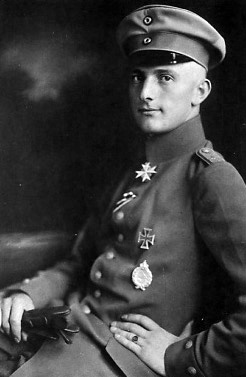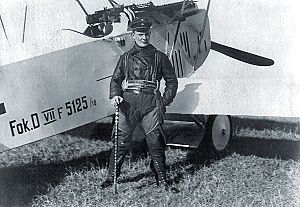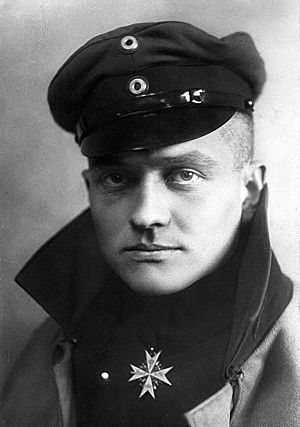Jagdgeschwader I (World War I) facts for kids
Quick facts for kids Fighter Wing 1 |
|
|---|---|
| Jagdgeschwader I | |
| Country | |
| Branch | Luftstreitkräfte |
Jagdgeschwader I (JG I) was a famous German fighter pilot group during World War I. It was made up of four smaller fighter squadrons called Jastas. This group was the first of its kind. It was created on June 24, 1917, and led by the legendary pilot Manfred von Richthofen. JG I was formed by bringing together Jastas 4, 6, 10, and 11.
JG I became known as "The Flying Circus" (German: Der Fliegende Zirkus) or "Richthofen's Circus." This nickname came from the bright colors of their airplanes. It also came from how the group moved around. They traveled like a circus from one battle area to another, often by train, setting up tents on temporary airfields.
Contents
How the Flying Circus Was Formed


In early 1917, German leaders realized they were often outnumbered in air battles. A typical Jasta (squadron) might only have six to eight planes. They often faced many Allied planes at once. To fight back better, Jastas started flying together in larger groups.
By mid-1917, the first official group of Jastas was formed: JG I. Its main job was simple: to gain control of the sky wherever it was sent. This meant stopping Allied planes from flying over certain areas. Because of this, JG I was a very mobile unit. It and its support teams moved quickly to different battlefronts as needed.
At first, the Jastas of JG I were based in different towns in Belgium. Richthofen had full freedom to pick his unit leaders and pilots. He could also remove any pilots he felt were not good enough. This policy helped make JG I an elite fighting group. Famous pilots like Eduard Ritter von Dostler, Hans Ritter von Adam, and Werner Voss joined the unit.
Operations in 1917
JG I quickly began flying intense missions over the Flanders battlefield. This was during an Allied attack that started in June 1917.
On July 6, Richthofen was badly wounded in the head during a fight. He was leading JG I against British F.E.2d planes. Oberleutnant Kurt-Bertram von Döring took temporary command. The very next day, Jastas 4 and 11 shot down nine Allied aircraft. Richthofen returned to command on July 25 but took more time off in September to recover.
JG I was the first unit to test the new Fokker Dr.I triplane. The first two of these planes arrived on August 21, 1917. Werner Voss of Jasta 10 became the best pilot with the triplane. He scored 10 victories in just 21 days before he was killed in battle.
Richthofen came back to JG I on October 23. Around this time, several Fokker Dr.I planes crashed. Because of this, JG I's technical officer grounded the triplanes until they could be fixed. The unit then flew with Albatros D.V. planes instead.
By November 23, 1917, JG I was quickly moved to Cambrai. This was after the British launched a big attack there. JG I helped a lot to stabilize the air war when the weather allowed.
By the end of 1917, JG I's success led to other similar groups being formed. In February 1918, Jagdgeschwader II and Jagdgeschwader III were created. Around this time, Richthofen brought in new talented pilots like Hans Kirchstein, Fritz Friedrichs, and Ernst Udet.
The Year 1918
Bad weather in early 1918 meant fewer chances for JG I to score victories. However, the unit was at the front lines during a major German attack on March 21, 1918. By April 1918, the group was flying from Harbonnieres. This was their most southwestern airfield. The newly formed British Royal Air Force (RAF) still had some control of the air. They flew observation and reconnaissance planes, often with strong fighter escorts. Most of JG I's victories at this time were against low-flying fighter-bombers, especially Sopwith Camels.
After Manfred von Richthofen's death in April 1918, Hauptmann Wilhelm Reinhard became the new commander of JG I. On May 10, JG I claimed its 300th victory. On May 20, the unit received the special name JG I 'Richthofen' in honor of their fallen leader.
Soon after, JG I moved to support a new German attack. This attack, called the Aisne offensive, began on May 27. JG I moved to Guise and then Puiseux Ferme. They mostly fought against French and newly arrived American Air Forces. Between May 31 and June 8, JG I claimed about 43 French planes and balloons. They claimed another 24 between June 24 and June 28. Lt. Hans Kirschstein of Jasta 6 was a top performer for JG I then. He claimed 27 victories between March 18 and June 14.
By mid-June, JG I was fully equipped with the new Fokker D.VII planes. Jasta 10 had tested the first ones in late May. After Reinhard was killed in a flying accident on July 3, 1918, Oberleutnant Hermann Göring became JG I's third and final commander of the war on July 14.
The Geschwader (wing) moved again on July 19 to Soissons. They claimed their 500th victory on July 25. Another move followed on August 10, to the front west of Saint-Quentin. On this same day, JG I's top scorer, 53-kill Leutnant Erich Loewenhardt, was killed in a mid-air collision.
JG I was very busy during the Amiens battle in August 1918. By mid-September, the exhausted unit was pulled back from the British front. By the end of August, all four Jasta commanders had been lost. Loewenhardt of Jasta 10 was killed. Jasta 6's Co Lt. Paul Wenzel and Lothar von Richthofen of Jasta 11 were both wounded and sent to the hospital. Lt. Ernst Udet (Jasta 4) was exhausted and sent on leave. JG I claimed only 17 victories in September. This was despite it being the month with the highest losses for the Allied Air Forces. For the next three months, pilots like Leutnant Friedrich Noltenius (Jasta 11), Jasta 6's Commander Ulrich Neckel, and Leutnant Arthur Laumann (Jasta 10) did most of the scoring.
Until the end of the war, JG I faced many challenges. There were shortages of fuel and spare parts. Allied air forces also grew much larger. German ground forces were constantly retreating. All these factors meant JG I struggled to repeat its earlier successes.
From June 1917 until November 1918, JG I claimed 644 Allied aircraft destroyed. During this time, they lost 52 pilots killed in action and 67 wounded.
Famous Pilots of JG I
Many brave and skilled pilots flew with Jagdgeschwader I. Here are some of the most famous:
- Eduard Ritter von Dostler – 26 victories
- Friedrich Friedrichs – 21 victories, including 10 observation balloons
- Hermann Göring – 22 victories
- Arthur Laumann – 28 victories
- Erich Loewenhardt – 54 victories, making him the third highest-scoring German ace of World War I
- Friedrich T. Noltenius – 21 victories
- Wilhelm Reinhard – 20 victories
- Lothar von Richthofen – 40 victories
- Manfred von Richthofen – known as the Red Baron, with 80 victories, he was the highest-scoring ace of any nation in World War I
- Wolfram Freiherr von Richthofen – 8 victories
- Ernst Udet – 62 victories, making him the second highest-scoring German ace of World War I
- Werner Voss – 48 victories
- Hans Weiss – 16 victories
- Kurt Wolff – 33 victories
See Also
 In Spanish: Jagdgeschwader I (Primera Guerra Mundial) para niños
In Spanish: Jagdgeschwader I (Primera Guerra Mundial) para niños
- Jasta 11
- Taktisches Luftwaffengeschwader 71 "Richthofen"
- Luftstreitkräfte
- Luftwaffe


